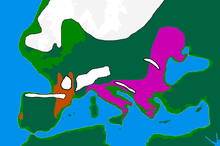
Back Refugij (biologija) BS Refugi (biologia) Catalan Refugium (ekologie) Czech Refugium (økologi) Danish Refugialraum German Refugio (biología) Spanish Refuugium Estonian پناهگاه (زیستشناسی جمعیت) Persian Refugi Finnish Refúgium Hungarian

In biology, a refugium (plural: refugia) is a location which supports an isolated or relict population of a once more widespread species. This isolation (allopatry) can be due to climatic changes, geography, or human activities such as deforestation and overhunting.

Present examples of refugial animal species are the mountain gorilla, isolated to specific mountains in central Africa, and the Australian sea lion, isolated to specific breeding beaches along the south-west coast of Australia, due to humans taking so many of their number as game. This resulting isolation, in many cases, can be seen as only a temporary state; however, some refugia may be longstanding, thereby having many endemic species, not found elsewhere, which survive as relict populations. The Indo-Pacific Warm Pool has been proposed to be a longstanding refugium, based on the discovery of the "living fossil" of a marine dinoflagellate called Dapsilidinium pastielsii, currently found in the Indo-Pacific Warm Pool only.[1]
For plants, anthropogenic climate change propels scientific interest in identifying refugial species that were isolated into small or disjunct ranges during glacial episodes of the Pleistocene, yet whose ability to expand their ranges during the warmth of interglacial periods (such as the Holocene) was apparently limited or precluded by topographic, streamflow, or habitat barriers[2][3][4]—or by the extinction of coevolved animal dispersers.[5] The concern is that ongoing warming trends will expose them to extirpation or extinction in the decades ahead.[6][7]
In anthropology, refugia often refers specifically to Last Glacial Maximum refugia, where some ancestral human populations may have been forced back to glacial refugia (similar small isolated pockets on the face of the continental ice sheets) during the last glacial period. Going from west to east, suggested examples include the Franco-Cantabrian region (in northern Iberia), the Italian and Balkan peninsulas, the Ukrainian LGM refuge, and the Bering Land Bridge. Archaeological and genetic data suggest that the source populations of Paleolithic humans survived the glacial maxima (including the Last Glacial Maximum) in sparsely wooded areas and dispersed through areas of high primary productivity while avoiding dense forest cover.[8] Glacial refugia, where human populations found refuge during the last glacial period, may have played a crucial role in shaping the emergence and diversification of the language families that exist in the world today. [9]
More recently, refugia has been used to refer to areas that could offer relative climate stability in the face of modern climate change.[10]
- ^ Mertens KN, Takano Y, Head MJ, Matsuoka K (2014). "Living fossils in the Indo-Pacific warm pool: A refuge for thermophilic dinoflagellates during glaciations" (PDF). Geology. 42 (6): 531–534. Bibcode:2014Geo....42..531M. doi:10.1130/G35456.1. S2CID 131220626. Archived from the original (PDF) on 2020-02-15.
- ^ Davis, Margaret B (October 1989). "Lags in vegetation response to greenhouse warming" (PDF). Climatic Change. 15 (1–2): 75–82. Bibcode:1989ClCh...15...75D. doi:10.1007/bf00138846. S2CID 154368627.
- ^ Davis, Margaret B; Shaw, Ruth B (27 April 2001). "Special Reviews: Range shifts and adaptive responses to Quaternary climate change". Science. 292 (5517): 673–679. doi:10.1126/science.292.5517.673. PMID 11326089.
- ^ Petit, Remy J; et al. (August 2004). "Review: Ecology and genetics of tree invasions: from recent introductions to Quaternary migrations". Forest Ecology and Management. 197 (1–3): 113–137. doi:10.1016/j.foreco.2004.05.009.
- ^ Svenning, Jens-Christian; Skov, Flemming (2007). "Ice age legacies in the geographical distribution of tree species richness in Europe". Global Ecology and Biogeography. 16 (2): 234–235. Bibcode:2007GloEB..16..234S. doi:10.1111/j.1466-8238.2006.00280.x.
- ^ Seliger, Benjamin J; McGill, Brian J; Svenning, Jens-Christian; Gill, Jacqueline L (November 2020). "Widespread underfilling of the potential ranges of North American trees". Journal of Biogeography. 48 (2): 359–371. doi:10.1111/jbi.14001. S2CID 228929332.
- ^ Manes, Stella; et al. (2021). "Endemism increases species' climate change risk in areas of global biodiversity importance". Biological Conservation. 257: 109070. Bibcode:2021BCons.25709070M. doi:10.1016/j.biocon.2021.109070. S2CID 234841035.
- ^ Gavashelishvili A, Tarkhnishvili D (2016). "Biomes and human distribution during the last ice age". Global Ecology and Biogeography. 25 (5): 563–574. Bibcode:2016GloEB..25..563G. doi:10.1111/geb.12437.
- ^ Gavashelishvili, A; et al. (2023), "The time and place of origin of South Caucasian languages: insights into past human societies, ecosystems and human population genetics", Scientific Reports, 13 (21133), doi:10.1038/s41598-023-45500-w, PMC 10689496
- ^ Ashcroft MB (2010). "Identifying refugia from climate change". Journal of Biogeography. 37 (8): 1407–1413. Bibcode:2010JBiog..37.1407A. doi:10.1111/j.1365-2699.2010.02300.x. S2CID 55909358.